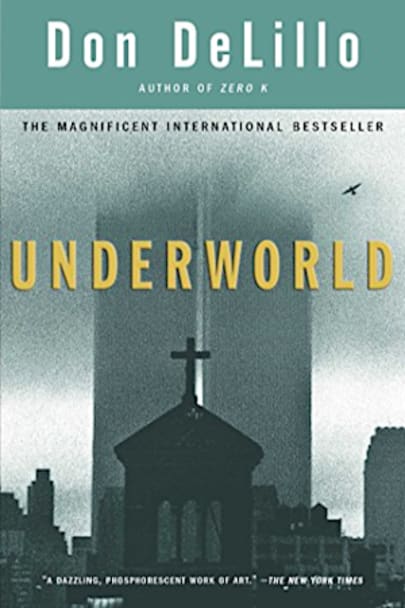A finalist for the National Book Award, Don DeLillo’s most powerful and riveting novel—“a great American novel, a masterpiece, a thrilling page-turner” (San Francisco Chronicle)—Underworld is about the second half of the twentieth century in America and about two people, an artist and an executive, whose lives intertwine in New York in the fifties and again in the nineties. With cameo appearances … cameo appearances by Lenny Bruce, J. Edgar Hoover, Bobby Thompson, Frank Sinatra, Jackie Gleason and Toots Shor, “this is DeLillo’s most affecting novel…a dazzling, phosphorescent work of art” (Michiko Kakutani, The New York Times).
more



“Underworld” is Don DeLillo’s complex paean to the Cold War era in the USA. First published in 1997, the 1999 paperback edition (Picador) comes in at 827 pages. Awards for the novel include a Pulitzer Prize Nominee for Fiction (1998), American Book Award (1998), and more.
While deeply immersed in this complex novel, I thought that a better title would be “Underworlds.” The shift to the plural would more accurately portray the many underworlds that are woven through the narrative. The author shows us a universe of subterranean worlds made of this bit of society or that bit of culture. These nether regions form the pillars that support the visible world, the shiny and chrome trimmed above-ground world of Cold War USA.
The dark regions below the visible surface form a tangled web. The reader is warned not to venture lightly into the darkness. “Underworld” is a complex novel, one that requires a great deal of participation and attention from the reader. We begin in the storied past of a famous baseball game, the last game of the 1951 Giants-Dodgers pennant race. This is the stuff of Americana fable. The author uses the game-winning home run, “The Shot Heard Round the World,” as the unifying thread of his far-reaching narrative. The thread wanders back and forth in time and character perspective. Time to pay attention: We really are going somewhere.
The reader is taken forward in time, from 1951 to the 1990’s, where things get more complicated. We begin an amazing tour of the many worlds below our normal range of vision. There is the dread and doubt of the cold war delivered in the persona of Lenny Bruce. We see the the Bronx through the soft lens of memory and then again in the harsh and brutal light of the present. There is baseball and the Bomb, until the threat of the bomb fades into the real danger of being buried in our own modern underworld of garbage. Art collides with culture and garbage with geography.
The narrative follows the trail of a single, historical baseball. That erratic thread leads past gangsters and nuns, artists and anarchists. It wanders through the darkness of J. Edgar Hoover’s mind and the crazed actions of shadow garbage terrorists. There are killers and executives, criminals and chess players, and all of their stories are interlaced in a delicate web. Some of these stories barely glance off of one another; others collide full force. The collisions and caroms become more interwoven as the novel progresses. More and more pieces fall into place for the reader. Therein lies the joy of this novel, as well as the pitfall.
A reader requiring a clear and linear narrative will be left in despair: There is the pitfall. The joy is revealed as one thread clicks into another as the narrative takes shape. The readers patience is not strained along the way. The fragments of story are fascinating in and of themselves. Fifty or a hundred pages later that fragment falls into place with an almost audible ‘click’ and more structure is revealed.
“Underworld” is a complex novel, and not one to be entered into lightly. And yet the Author pulled me into the story from the very first pages and never let me go. Five decades of interwoven stories and not once did I feel my time as a reader was wasted. I was immersed in DeLillo’s world, deeper and deeper as the story unfolded, and I was happy to be there. This is a fine novel, delicately woven with infinite care and cunning. The diligent reader will be rewarded every page of the way. I highly recommend this novel to serious readers; five stars without hesitation.
The writing seems great but it was just too dense and slow-moving for me. Maybe I’m just in the wrong headspace in the middle of a pandemic.
This was a very interesting story with a unique premise – every character and every time period was somehow connected by a baseball. It was recommended by some folks in a mystery readers book club I belong to, and I decided to try it out. I’m glad I did.
While it would have been easier to follow the time-switchbacks in reading the book, I was able to keep track in the audio version by listening to the book over a period of just a couple of days instead of stretching over a week or so like I usually do for audio.
It takes a while for the story to develop enough that the reader “gets it” about the baseball, but it is well worth waiting for. The characters are engaging enough that I was drawn into the story. Well-defined characters will do that for me all the time.
Delillo’s best book.